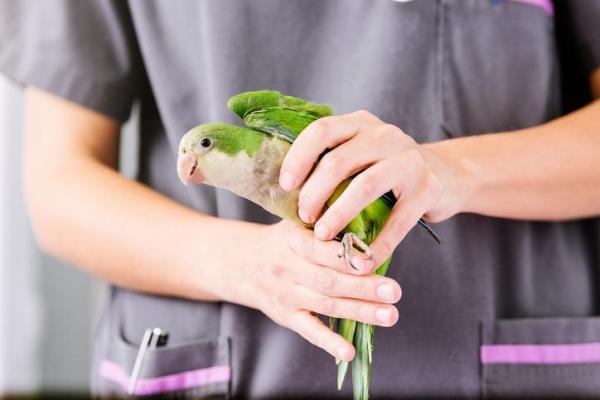4 Signs of Stress in Parrots


One of the most common patients in exotic animal veterinary clinics is the parrot. Whether they be a lovebird, cockatiel or macaw, they are prone to certain ailments. Some of these can be exacerbated by their living conditions, but it is not always easy to detect the signs. Common diseases include colibacillosis, parasitosis, pneumonia and psittacosis. Although fatal in some cases, the prognosis can be good when given enough time for treatment.
A parrot's living conditions, however, can lead to behavioral problems and stress. Whether a parrot finds certain living conditions stressful seems to depend on the personality of the individual parrot, although a lack of environmental enrichment is a big factor.
For this reason, if you suspect your parrot may be suffering from anxiety, we advise you to review these 4 signs of stress in parrots. Let AnimalWised help you identify these stress symptoms, so that if you do recognize them you don't hesitate in taking them to a specialized veterinary center.
Abnormal behavior and stereotypies of parrots in captivity
Stereorypies are a range of behaviors which can are abnormal, repetitive, without an apparent function and unchanging. They are common signs of mental duress which can affect both captive and domestic animals, largely due to adverse living conditions and poorly enriched environments. These types of behaviors are much less common in nature as these creatures live in a habitat which is large, free and full of enrichment.
In parrots, these behaviors tend to occur in those which don't have enough sensory stimuli. This means they don't have enough opportunity to interact with different objects or have a lack of control over their own environment. The biggest problem is that many people adopt one or several of these birds and are unable to recognize such behaviors due to a lack of experience or training. Some may even think what is actually a stereotypy is a fun quirk and take videos rather than improving the parrot's conditions.
Additionally, many parrots will perform these habits and behaviors when they are alone, their human owners not always able to see these displays of stress and frustration. If you fear your parrot is suffering from stress (from recognizing one of these signs of stress in parrots), then you can try setting up a recording device to see how they behave when no one is around.
You may see certain stereotypies or ticks such as the one below:

4 Signs of stress in parrots
1. Feather-Plucking
Many people who live with parrots will see the behavior of feather-plucking, scientifically known as pterotillomania. It is a common sign of stress, so prevalent that it is estimated that one in ten parrots in captivity plucks their feathers[1].
Unlike other stress symptoms in parrots, this one is relatively easy to discern. If you look at a parrot and they have lost sections of their plumage and there is no other viable reason for them to have them missing, then it is likely they are plucking feathers. Feather plucking never happens from the head, only the body. When the plucking extends to small wounds on the bird's skin, it is a sign of a serious anxiety problem.
This behavior appears without any underlying medical reason. Scientific studies suggest it is likely related to poor parrot management involving an inadequate diet, social isolation, noise pollution and lack of environmental stimulation. In regard to social isolation, it is important to take into account that once a parrot finds a mate (whether another parrot or even developing strong bonds with humans), their absence can cause significant stress. If we have built a strong bond with the bird and then have to go for long periods of time, this could be a potential cause of stress in the parrot.
It is also vital not to over-manipulate a parrot and avoid giving them too much affection. This stress behavior can also be related to poor foraging behavior (searching for food). As food is always available without requiring any foraging, it can cause a bird to become bored and stressed.
2. Screaming
The second sign of stress in parrots is continued screaming. It is also one of the most common causes of pet owners abandoning birds. Oral communication in parrots is a natural and common behavior. When their vocalization becomes more acute and repetitive, it is often an alarm signal which the bird uses to call out in distress. They may even be calling out to distant relatives who are not in their vicinity.
When these cries become constant and repetitive for no apparent reason, it is abnormal and may be a sign of boredom or stress. It has been shown that parrots paired with other birds are less likely to develop these signs of stress. This is from a study carried out on young Orange-winged Amazon parrots in 2003[2].
3. Fear and excessive aggression
Excessive aggression and fear reactions are a common symptom of stress in birds. These behaviors limit the interactions between parrots that live in the same cage or between a parrot and their human guardian. Additionally, due to this aggression, many parrots incur injuries. A fearful parrot which continuously tries to escape or panics easily is more likely to be abandoned.
With parrots, such as parakeets and cockatiels, new people, objects or animals in their environment can trigger fear or aggression. This is usually do to the parrot in question being raised in a poor environment, devoid of stimuli and with poor socialization. it has been shown that individuals raised in a highly stimulating environment are less likely to suffer stress and develop these types of problems.
4. Stress walking
With this stress behavior, a parrot will continuously and invariably repeat a route within its cage. Parrots in the wild live in large groups. When we keep a parrot isolated from other members of their species, certain behaviors such as foraging are not carried out properly. Therefore, one way to keep our parrot stimulated, if we are unable to introduce a new parrot, is to hide food in their cage and allow them to go looking for it. In doing this, the parrot entertains itself and reduces stress.
Environmental enrichment
Enriching our parrots environment can greatly increase the welfare of our pet parrot. We need to provide them with a large enough cage where they can walk, fly a little and stretch out freely. We also need to provide objects for them to interact with and, ideally, have some peers with which they can socialize. If we detect signs of stress, think what you can do to make them happier.
Encouraging foraging behavior is also very important. We don't just have to do this with food. Finding toys or objects which they desire is a positive behavior and can help reduce stress. Many parrot owners will see that their individual bird chooses certain objects they seem to enjoy which are not toys or are simply everyday objects we have around the home. These types of interactions will help reduce stress and lessen the risk of harmful behavior.
If we see any of these symptoms in our parrots, we need to go to the vet. A specialized veterinarian who know about exotic animals is required, but you may have to take them to the regular vet for a referral.

If you want to read similar articles to 4 Signs of Stress in Parrots, we recommend you visit our Behavioral problems category.
1. Van Zeeland, Y. R. A., et al. (2009). Feather Damaging Behaviour in Parrots: A Review with Consideration of Comparative Aspects. Applied Animal Behavior Science, 121(2), 75-95.
https://www.sciencedirect.com/science/article/abs/pii/S0168159109002561?via%3Dihub
2. Meehan, C. L., Garner, J. P., & Mench, J. A. (2003). Isosexual Pair Housing Improves the Welfare of Young Amazon Parrots. Applied Animal Behavior Science, 81(1), 73-88.
https://www.researchgate.net/publication/248335896_Isosexual_pair_housing_improves_the_welfare_of_young_Amazon_parrots







